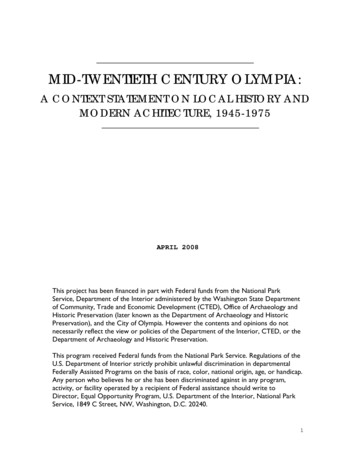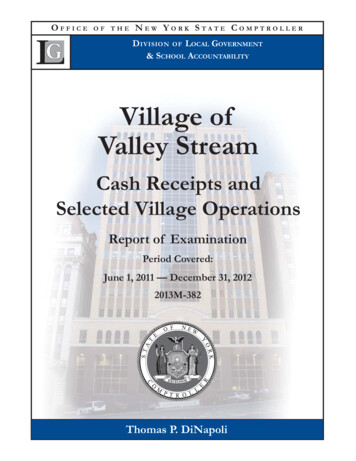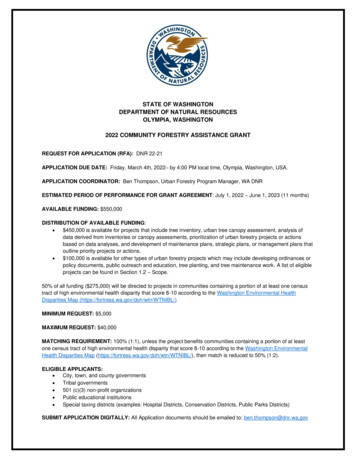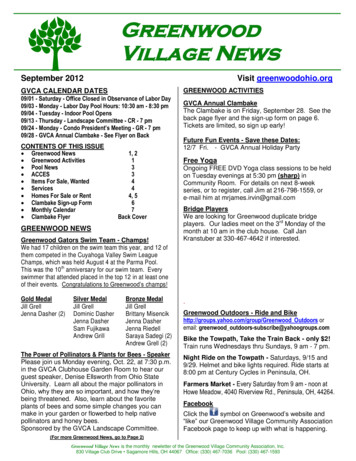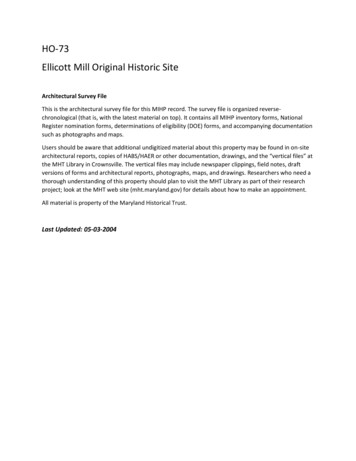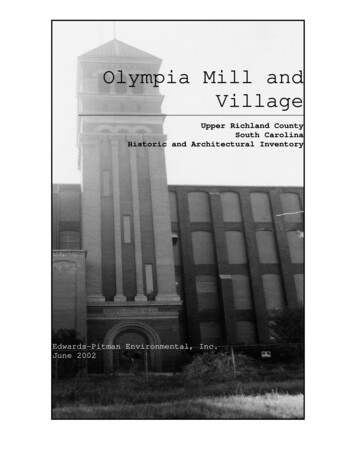
Transcription
Olympia Mill andVillageUpper Richland CountySouth CarolinaHistoric and Architectural InventoryEdwards-Pitman Environmental, Inc.June 2002
OLYMPIA MILL AND VILLAGEUpper Richland County, South CarolinaHistorical and Architectural InventoryEdwards-Pitman Environmental, Inc.Jennifer F. MartinNicholas G. TheosSarah A. WoodardFunded byThe Richland County Conservation CommissionandThe South Carolina Department of Archives and HistoryJune 2002The activity that is the subject of this report has been financed in partwith Federal funds from the National Park Service, U.S. Department ofthe Interior, and administered by the South Carolina Department of Archivesand History. However, the contents and opinions do not necessarily reflectthe views or policies of the Department of the Interior.This program receives Federal financial assistance for identificationand protection of historic properties. Under Title VI of the Civil RightsAct of 1964, Section 504 of the Rehabilitation Act of 1973, and the AgeDiscrimination Act of 1975, as amended, the U. S. Department of theInterior prohibits discrimination on the basis of race, color, national origin,disability or age in its federally assisted programs. If you believeyou have been discriminated against in any program, activity, or facility asdescribed above, or if you desire further information please write to:Office of Equal Opportunity, National Park Service, 1849 C Street, N.W.,Washington DC 20240.
AcknowledgementsSeveral individuals provided assistance without which we would not have been able to carry outthis survey. Daniel J. Vivian, who served as the Survey Coordinator for the South Carolina StateHistoric Preservation Office during the majority of the project, offered excellent advice andtechnical assistance. Nick, Sarah and I wish him the best in his new job in Washington, D.C. BradSauls, the Grants Coordinator for the SHPO, made sure the project ran smoothly and gracefullytook over the project after Dan’s resignation. Ash Miller, who, like Dan Vivian, left his positionwhile we were working on the project, exuded an air of professionalism and warmth that madethe project totally enjoyable. We also wish him well in his new endeavor. Ashley Jacobs, whotook over Ash Miller’s position at the Richland County Administrator’s office, provided muchassistance as the project concluded. Leigh Edwards, a consultant for the Palmetto Trust,accompanied us in the field and showed a sincere interest in the survey. The staffs of the SouthCarolina Archives Search Room, the South Caroliniana and Thomas Cooper libraries at theUniversity of South Carolina and the local history room at the Richland County Public Librarydelivered their assistance in a timely and friendly manner.We also acknowledge the outstanding citizens of upper Richland County without whom thisproject would have been impossible. Many, many people provided historical information anddirections to resources we might otherwise have overlooked. The people in and around Pontiac,Blythewood, Cedar Creek, White Rock, Ballentine and everywhere in between showed thegenuine hospitality for which we South Carolinians are known. In particular, we would like torecognize Margaret DuBard, Pepper Ellisor, Fred York and Connie Martin, each of whomaccompanied us in the field. Finally, we would like to thank Paige, Parker, Janice and SpencerAllen for providing us a home base from which to work.We extend our deepest gratitude to all of you.Sarah WoodardRaleigh, North Carolina12 June 2002
OLYMPIA MILL AND VILLAGEUpper Richland County, South CarolinaHistorical and Architectural InventoryTable of ContentsI.List of Plates1II.Introduction2III.Project Summary2IV.Project Objectives3V.Survey Methodology4VI.Historical OverviewThe Textile Industry in ColumbiaThe Olympia MillThe Olympia Mill Village61517VII.Bibliography22VIII.Evaluation of Recorded Properties24IX.Data Gaps30X.Recommendations30XI.Appendices34Compiled InventoryNational Register Criteria
OLYMPIA MILL AND VILLAGEUpper Richland County, South CarolinaHistorical and Architectural InventoryI. List of Plates and FiguresPlates1. Image from Columbia souvenir booklet, ca. 191062. Olympia Mill, from Columbia souvenir booklet, ca. 1910153. Typical Olympia Mill Village house184. Gable-front house with inset porch255. One-story, L-shaped house266. Two-story, six-room, side-gable house with saltbox shed267. Duplex with two-story unit and one-story unit278. Two-story shotgun house27Figures1. Map of Olympia Village Survey Area52. Map of Potential Olympia Mill Village National Register District32Olympia Mill and VillageHistorical and Architectural InventoryEdwards-Pitman Environmental, Inc.1
II. IntroductionIn July 2001, the Richland County Conservation Commission and the SouthCarolina State Historic Preservation Office (SCSHPO) engaged Edwards-PitmanEnvironmental, Inc. to conduct an intensive architectural survey of upperRichland County and the Olympia Mill village. Because the Olympia Surveycovers a specific area with a common history dating to a particular era, the UpperRichland survey report is under a separate cover. All information relating to theboundaries of the survey area, survey methodology and the number of propertiesdocumented that follows pertains specifically to the survey of the Olympia MillVillage.An initial planning meeting was held in the Richland County Administrator’soffice on 25 July 25 2001. Among those in attendance were Andrew Pitman,Nicholas Theos and Jennifer Martin representing Edwards-Pitman Environmental,Inc.; Margaret DuBard, a member of the Richland County ConservationCommission; Daniel J. Vivian and Brad Sauls of the SCSHPO; T. PatrickBrennan, Executive Director of Historic Columbia Foundation; Leigh Edwards, aconsultant for the Palmetto Conservation Foundation and Ash Miller, the project’slocal coordinator who also serves as the county’s staff person for the RichlandCounty Conservation Commission. On July 27, the contract for the survey wassigned and work was underway. Fieldwork took place in October 2001. Data foreach resource surveyed was entered into the Department of Archives and HistorySurvey Database in the late fall and winter of 2001 and early 2002. In January andFebruary of 2002, historians for Edwards-Pitman Environmental conductedfurther research on the history of the county and prepared this final report.III. Project SummaryA. Name of SurveyHistoric Resources Survey of Upper Richland County: Olympia Mill VillageB. Boundaries of Survey AreaLocated just south of downtown Columbia, the survey area includes the originalOlympia Mill property, based on plat maps from 1940. The area is bounded on thenortheast by Bluff Road, by Granby Lane on the southeast, by the VulcanMaterials quarry property and a portion of Olympia Avenue on the southwest, andby Heyward Street on the north.C. Number of Properties Surveyed382Olympia Mill and VillageHistorical and Architectural InventoryEdwards-Pitman Environmental, Inc.2
D. Number of Square Miles SurveyedApproximately .35 square milesE. SurveyorsNicholas Theos, Jennifer F. Martin and Sarah A. WoodardEdwards-Pitman Environmental, Inc.F. Beginning and End Dates of SurveyOctober 22 – October 26, 2001IV. Project ObjectivesThe survey of the Olympia Mill Village is a component of the Historic ResourcesSurvey of Upper Richland County, a project funded through a matching grantprogram by the South Carolina Department of Archives and History and RichlandCounty. This survey is part of the on-going statewide survey programadministered by the State Historic Preservation Office, within the South CarolinaDepartment of Archives and History. The state’s survey program is intended topreserve and document South Carolina’s history by collecting information aboutthe state’s historic architecture.The survey of the Olympia Mill Village will allow the State Historic PreservationOffice to evaluate the potential for including the village in the National Registerof Historic Places, which is the nation’s list of historic resources worth ofpreservation. Listing in the National Register of Historic Places is primarilyhonorary, but does provide the opportunity for some property owners to takeadvantage of tax incentives. The National Register also helps create awareness ofthe neighborhood’s existence and importance when reviews of federally funded orlicensed projects are slated to occur in the area.The survey will also raise the village’s historical value among the residents aswell as provide a history of the mill and the village and a list or inventory of allthe structures and buildings extant in the village. The survey will provide villageresidents with access to their history, inspiring future preservation efforts. Beyondthe village, the survey will gather the information needed by local officials whenthey are asked to make sound planning decisions. Awareness of Olympia’s historywill also be raised among the broader population of Columbia and RichlandCounty, which will, in turn, help citizens appreciate, understand, preserve, andremember its whole history.Olympia Mill and VillageHistorical and Architectural InventoryEdwards-Pitman Environmental, Inc.3
V. Survey MethodologyThe survey of Upper Richland County followed the Secretary of the Interior’sStandards for Identification and Evaluation (36 CFR 61.3 and 6 and 61.4[b]) andwas devised in accordance with the “State Historic Preservation Office SurveyManual,” revised 2001 edition, issued by the South Carolina Department ofArchives and History.A. Fieldwork and ResearchThe surveyors conducted the fieldwork between October 22 and October 26,2001. Surveyors walked or drove every street within the area and for each pre1952 building, they completed a reconnaissance level survey form, taking blackand white photographs, and mapping each building, site, and structure within thesurvey area. All surveyed properties were mapped on a map provided by RichlandCounty. In addition to surveyed properties, the consultants noted the locations ofvacant lots and infill construction on the map.Before, during and after the fieldwork phase of the project, the investigatorsgathered history concerning the mill village from current and former residents, theSouth Carolina Division of Archives and History, the South Caroliniana and theThomas Cooper Library at the University of South Carolina, the Richland CountyPublic Library, the Wilson Library at the University of North Carolina, and theNorth Carolina State University library.B. Criteria for EvaluationAll resources more than fifty years in age were included in the survey, regardlessof integrity. The surveyors attempted to err on the side of inclusion, occasionallysurveying buildings less than fifty years old with indefinite construction dates orwith construction dates close to the fifty-year cut-off.Olympia Mill and VillageHistorical and Architectural InventoryEdwards-Pitman Environmental, Inc.4
Figure 1: Map of Olympia Village Survey AreaOlympia Mill and VillageHistorical and Architectural InventoryEdwards-Pitman Environmental, Inc.5
Plate 1: Image from Columbia souvenir booklet, ca. 1910VI. Historical OverviewThe Textile Industry in ColumbiaOlympia Mill Village is situated just south of downtown Columbia, immediatelyoutside the city limits. South Carolina’s capital city sits on the eastern side of theconfluence of the Saluda and Broad Rivers, which together form the Congaree River.The city is nearly in the center of the state and was officially established as the seat ofstate government following the American Revolution, although the area had been settledsince the mid-1700s. Throughout the first half of the nineteenth century, Columbia’spopulation grew as state government and commerce expanded. Following the Civil War,Columbia, like other southern cities and the rest of South Carolina, faced a period of slowrecovery and adjustment as the region moved towards a New South economy fueled byrailroads and industrialization. 1The concept of a New South developed after the Civil War and reached its heightin the 1890s and 1910s. The New South aimed at making the region less dependent onagriculture through economic progress, civic duty, and social changes. The movement’sleaders wanted, in effect, to make the South more like the North. The main component inthe creation of this reinvented region, particularly in the Piedmont regions of North andSouth Carolina, Georgia and Alabama, was the textile mill. In South Carolina, textileproduction dates from the mid-eighteenth century when yarn and cloth were produced inprivate homes and in small factories for very limited local consumption. Antebellumindustrial pursuits were conducted only on a small scale and most antebellum SouthCarolinians grew cotton or produced other raw materials that would be manufacturedelsewhere.1Historic Preservation Consulting, Inc., “Granby Mill Village Historical Survey,” survey report, 1990, 3-4.Olympia Mill and VillageHistorical and Architectural InventoryEdwards-Pitman Environmental, Inc.6
There were, however, a few exceptions. One in particular was William Greggwho, in 1847, set up a large textile plant in South Carolina. Called the GranitevilleManufacturing Company, the factory was equipped with 9,245 spindles and 300 looms,making it the largest antebellum textile factory in the South, and one of the region’slargest industrial plants. 2 Like New England manufacturers, Gregg establishedGraniteville in a rural area where he could take advantage of waterpower, and providedhousing, stores, hotels, churches, and schools for workers and their families because themill stood isolated from community services. By following the New England pattern,Gregg helped establish the method of mill development that the South followed fiftyyears later when it transformed itself into the post-Civil War, industrialized, New South. 3Thirteen years after Gregg founded his company, only eighteen cotton millsoperated in South Carolina. These factories housed 26,000 spindles and employed 891people. By comparison, Massachusetts’ 271 mills had over one and a half millionspindles and employed 38,451 operatives. 4The textile industry’s slow growth ceased altogether with the outbreak of the CivilWar. In February 1865, Union troops, apparently under the influence of alcohol ratherthan Sherman’s command, set much of Columbia ablaze, destroying the business district,homes, and the old State House. The new capitol, still under construction, was damagedand railroad tracks were torn up. Although not completely devastated, Columbia was leftbattered and bruised. 5 When the war ended, railroad companies repaired tracks and builtnew rail lines, and by the turn of the twentieth century, Columbia functioned as a regionalrail hub with eleven separate rail lines bringing 144 trains to the city daily. 6Simultaneously, advances were being made in the creation and use of electricitywhile New South entrepreneurs were sounding the cry, “Bring the mills to the cotton.”South Carolina and Columbia were key participants in the New South movement and intextile mill development. With the New South focus on civic responsibility andindustrialization, South Carolina’s business leaders worked to instill community pridethrough the use of slogans and expositions. Spartanburg tried several slogans, amongthem, “The City of Smokestacks and Education.” Greenville became the “Pearl of thePiedmont.” 7 In 1901 and 1902, Charleston sponsored the less-than-successful SouthCarolina Interstate and West Indian Exposition, while in true New South fashion,Greenville hosted the wildly successful Southern Textile Exposition.8By the late nineteenth century, steam power and electricity eliminated thenecessity of locating mills near strong rivers, and thus, with the mill free from the2Stephen Shapiro, “The Growth of the Cotton Textile Industry in South Carolina: 1919-1930” (Ph.D. diss.,University of South Carolina, 1971), 5.3Shapiro, 6; Debra Miller Stayner, “Changing Geographic Patterns in Olympia Mill Village” (master’sthesis, University of South Carolina, 1984), 33.4Shapiro, 2-3.5John Hammond Moore, Columbia and Richland County: A South Carolina Community, 1740-1990(Columbia: University of South Carolina Press, 1993), 202-204.6Walter Edgar, South Carolina: A History (Columbia: University of South Carolina Press, 1998), 454.7Edgar, 255.8Edgar, 255-256Olympia Mill and VillageHistorical and Architectural InventoryEdwards-Pitman Environmental, Inc.7
constraints of waterpower, the desirability of providing worker housing faded in NewEngland. In the South, too, manufacturers had flexibility when choosing the location oftheir mills, but they continued to use rural locations where mill villages were necessary.The mill village allowed manufacturers to exercise paternalistic control over theirworkers and lure workers with the provision of housing.One of the leaders in the New South movement was Charlotte’s D.A. Tompkinswhose widely disseminated recommendations directed that a 10,000-spindle mill shouldhave five to ten acres for the mill site and about forty acres for houses, providing eachhouse with room for a garden. 9 He advised mill investors to build “a factory one to fourmiles away from a city and let the company build and own the houses the employees livein.” 10 This strategy avoided local property taxes, local governmental jurisdiction, andallowed mill owners to maintain social and economic control over their workers. 11Tompkins also noted that in a remote location, with no existing stores, “the benefit ofmercantile features may be enjoyed by the mill company.” 12 Furthermore, lawyers whomay attempt to interfere with the mill’s operations or sue over injuries that operativesmay sustain would also be kept at bay. 13 Tompkins believed downtown living wouldcorrupt workers, as would indoor plumbing or housing more spacious than one room peroperative and at the end of the day, employees in a rural setting would be more apt to goto bed early, and therefore would be in better condition to work during the day. 14Across the South, cotton mills were constructed at explosive rates. Fourteen millsstood in South Carolina in 1880, even fewer than in 1860. But between 1895 and 1907,sixty-one new textile mills were built and older ones were expanded and updated. By1910, there were 167 cotton mills in South Carolina, a number second only toMassachusetts. 15 A key group of South Carolina mill developers were responsible formuch of this boom. These barons included Leroy Springs, John T. Woodside, and LewisW. Parker whose company eventually operated more than one million spindles in SouthCarolina. Charleston native W.B. Smith Whaley, however, was South Carolina’s mainproponent of textile production and innovator in mill design. 16William Burroughs Smith Whaley (1866-1929), like many of his New Southcounterparts, received much of his education in the North, attending Stevens Institute ofTechnology and Cornell University, from which he graduated in 1888. After working as amechanical engineer in Rhode Island and being exposed to textile mill design andoperation, Whaley returned to South Carolina in 1893, establishing himself in Columbia9D.A. Tompkins, Cotton Mill Commercial Features: A Textbook for the use of Textile Schools andInvestors (Charlotte: D.A. Tompkins, 1899), 34.10Ibid.11Brent D. Glass, The Textile Industry in North Carolina (Raleigh: N.C. Department of Cultural Resources,1992), 42.12Tompkins, 35.13Ibid., 35.14Tompkins, 35 and Glass, 42.15Edgar, 256.16Ibid.Olympia Mill and VillageHistorical and Architectural InventoryEdwards-Pitman Environmental, Inc.8
as a mechanical engineer specializing in mill design. The following year, Whaley andGadsden E. Shand, a Columbia civil engineer, founded W.B. Smith Whaley andCompany. Between 1895 and 1907, the firm designed twenty-one mills in SouthCarolina, Georgia, Alabama, and North Carolina, most of them in South Carolina. One ofhis largest mills was the sixty thousand-spindle F.W. Poe Manufacturing Company inGreenville with over nine hundred employees. Through the firm’s work, Whaley andCompany introduced many architectural and technological innovations to mill design inSouth Carolina. 17Columbia’s mill development, both in and near the city, mirrors the history oftextile manufacturing across the Carolinas. From a slow antebellum start, textiles evolvedas the major economic engine in the city by the early twentieth century. Small textileconcerns operated in and around Columbia from its earliest days. The first substantialfactory was the Saluda Manufacturing Company, chartered in 1834 and located about twomiles north of Columbia. The company operated off and on for about fifty years, but itwas never a success and burned in 1884. The arrival of the railroad and improved energysources were necessary for modern textile production, but once those two needs weremet, the scene was set for the arrival of the modern manufacturing. Although New Southindustrialists like D.A. Tompkins recommended that mills be built along railroads in ruralareas, the allure of Columbia’s extensive rail connections and readily accessibleelectricity pulled manufacturing facilities towards the capital. As in Charlotte, severalmills were located on the edge of the city or just beyond the city limits, but despiteneighboring urbanity, mill villages were still constructed, lending credence to the notionof the mill owner’s desire for control of his operatives. By 1920, an estimated one-sixthof the state’s white population lived in mill villages. 18Columbia’s first post-Civil War mill was the Congaree Manufacturing Company,a small, steam-powered operation that proved unsuccessful and lasted only about threeyears. Three other mills began operating around the turn of the twentieth century.Founded in 1894, Columbia Mills Company was the first mill in the United States to bepowered entirely with electricity. The Palmetto Cotton Mills opened in 1899 and theGlencoe Cotton Mill began operations in 1909.Four other Columbia mills date from the textile boom-period of the latenineteenth and early twentieth century: Richland Cotton Mills Company (1895), GranbyCotton Mills Company (1897), Olympia Cotton Mills (1899), and the Capital City Mills(1900). Although the Richland Mill was a steam-powered facility, the other mills tookadvantage of the electricity produced at the recently completed hydroelectric plant on theColumbia Canal. Whaley and Company designed and managed these mills, collectivelyknown as the Whaley Mills, and they represent the firm’s most advanced and innovativedesigns. 1917National Register Multiple Property Documentation Form, “Textile Mills in South Carolina Designed byW.B. Smith Whaley, 1893-1903,” E 1 – 3.18David L. Carlton, Mill and Town in South Carolina: 1880-1920 (Baton Rouge: Louisiana StateUniversity Press, 1982), 7.19Historic Preservation Consulting, Inc., 5.Olympia Mill and VillageHistorical and Architectural InventoryEdwards-Pitman Environmental, Inc.9
The Whaley Mills, on the city’s southern edge and easily visible from the StateHouse, brought the New South economy to the capital as well as the poverty associatedwith mill villages. Workers labored from six in the morning to 6:30 p.m. Monday throughFriday and for nine hours on Saturday for wages that were, on average, sixty-percentlower than those earned by mill hands in other parts of the country. 20 An 1896“Christmas tree” benefit for impoverished children sponsored by The State, had to bepostponed from its Christmas Eve date to December twenty-sixth when it was discoveredthat most of the beneficiaries would be working at the mills on Christmas Eve, but wouldhave a half day off on Saturday, the twenty-sixth. By the following year, the ColumbiaLadies’ Benevolent Society was one of many local charities becoming overwhelmed byrequests for assistance and appealing to the public for more help: “Since theestablishment of more factories, there is a greater number of cases calling for relief, andthe illness of the past summer among this class, as well as among others, having depletedour treasury, we ask contributions from the generous-hearted whose sympathies aboundfor the poor.” 21In 1907, when August Kohn wrote The Cotton Mills of South Carolina, twothousand thirty-six people worked in the four Whaley Mills. Of those, officials reportedto Kohn that only thirty-two were under the age of twelve, but Kohn notes, “every milldid not freely give the desired data.” Kohn reported that of the three hundred fiftychildren living in the Olympia mill village, only one hundred and forty attended school. 22This was despite the fact that a 1903 South Carolina law directed that no child under tencould be employed in a factory, mine, or mill. The age increased to eleven in 1904 and totwelve in 1905. 23Mill owners and operators maintained control of the low-paid operatives andminimized complaints about hours, wages, and working conditions through well-appliedpaternalism. By providing housing that was often better than that the operatives had leftbehind in the country, schools, churches, recreational, and health facilities, ownersconvinced both workers and the public that the company was taking care of its own. Inreality, however, schools were poorly run and were often over-crowded or underattended, housing was sometimes sub-standard, churches were “designed less for theencouragement of religion than for its control,” and the company maintained pricecontrols at the store, often assisting in the operative’s descent into debt. 24Like the mill’s bell or whistle wafting into the mill house dictating the beginningand end of every shift, the company had access to every aspect of the operative’s life.Broadus Mitchell, in his 1930 book, The Industrial Revolution in the South, wrote, “Thechurch and the school, not to speak of the welfare departments, have been sponsored andcontributed to by the employers, and have been engines of his will and servers of his20Edgar, 460-461.Carlton, 135-136 and The State, October 23, 1897.22August Kohn, The Cotton Mills of South Carolina (Columbia: South Carolina Department ofAgriculture, Commerce, and Immigration, 1907), 109 and 139.23Edgar, 463.24Carlton, 101-104.21Olympia Mill and VillageHistorical and Architectural InventoryEdwards-Pitman Environmental, Inc.10
convenience.” He went on to say that operatives have been “stall fed,” receiving “aconsiderable part of their compensation in kind – gardens, medical attention, freepasturage, wood and coal at cost, and, above all, exceedingly low rents.” In this situation,workers were bound to the mill because they had little cash and operatives generallyaccepted the services of the mill in exchange for their silence about unsafe workingenvironments and unsanitary living conditions. Mitchell acknowledged that textile millsprovided employment to a segment of the rural population (poor, landless whites) thatwas often living in abject poverty, but he felt that “the company-owned mill village hassome time since become a means of repression of the worker, consciously maintained bythe employer.” 25Mitchell was not the only writer discussing the paternalism of the textile mill.Paul Blanshard, writing for the New Republic in 1927, reported, “What the mill workersgain in well repaired roofs and inside toilets, they lose in community control. . . . Theworker has neither standing as a citizen nor training for citizenship apart from thedominant figure of his industrial overlord.” 26 Indicating that the services provided by thecompany stifled reform, he wrote, “Social workers hired by kindly mill owners giveexcellent personal service, but they are not free to criticize the worst features of villagelife.” 27 By providing housing and other assistance to operatives, mill management hopedto stay beyond reproach in the eyes of the workers and the public.In Columbia, where since 1891 Labor Day had been celebrated with unusualgusto, labor unrest arrived early. The National Union of Textile Workers participated inthe 1900 Labor Day parade and began a call for child labor legislation, the establishmentof a state bureau of labor with inspection powers, and reduced working hours. AlthoughThe State reported, “Labor organizations have cut no figure here. The people are satisfiedwith a good living and want no disturbance of the amicable relations between capital andthemselves,” the management of the Whaley Mills nervously announced plans to build apublic hall, library, and school and donate land and money towards the construction of achurch. 28 This did not pacify workers and by August 1901, with many of his workersplanning to march in the Labor Day parade, Whaley ordered operatives to work overtimeto make up their lost hours in advance of the parade. When the mill hands failed to workovertime on Saturday, they found themselves locked out on Monday morning. On August28, mill employees went on strike, but the mills continued to run and strikers were giveneviction notices. Whaley, however, did not like The State’s coverage of the strike. Hedenounced the press, and thus lost a potentially valuable ally. Ultimately, with the unionunable to offer meaningful financial assistance to the strikers, the strike fizzled and justfour months later, workers presented Whaley with a gold watch for Christmas. 2925Broadus Mitchell, The Industrial Revolution in the South (Baltimore: The Johns Hopkins Press, 1930),136-137 and 141.26Paul Blanshard, “Servants of the Spindle,” The New Republic (September 28, 1927): 144.27Ibid., 145.28The State (Columbia), Industrial Art Edition, July 8, 1901; Moore, 311.29Moore, 311-312.Olympia Mill and VillageHistorical and Architectural InventoryEdwards-Pitman Environmental, Inc.11
Despite this element of dissatisfaction, the “extreme and cruel poverty” The Statefound in Columbia’s mill villages, and the control exercised by mill managers andowners, most villag
Typical Olympia Mill Village house 18 4. Gable-front house with inset porch 25 5. One-story, L-shaped house 26 6. Two-story, six-room, side-gable house with saltbox shed 26 . Olympia Mill Village is situated just south of downtown Columbia, immediately outside the city limits. South Carolina's capital city sits on the eastern side of the
